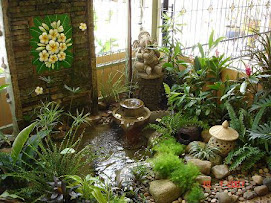Wildlife Gardening: Attracting Wild Visitors
Author: Linda Pollitt
Why is it so Important?
In recent years, the popularity of wildlife gardening has grown dramatically. Not only are gardeners increasingly aware of our declining wildlife and keen to play a role in its survival, but they are also discovering the joy of sharing a garden with native species.
We share our small garden with birds, frogs, toads, hedgehogs and even the odd fox. Nothing quite beats the magic of breakfast outside on a sunny morning, watching the birds feed, squabble and sing.
Jane Davies.
The past 100 years have seen the loss of some of our most precious habitats. Ecologist Janice Crook explains "Estimates vary widely, but it seems that since 1945 we have lost something like 50% of our ancient woodland, and 95% of our flower-rich meadows." Little wonder then that many of our most loved wild animal species have also declined dramatically. Even once common species such as tree sparrows are at risk – these lively garden visitors are now on the RSPB's red data list for endangered species.
Even tiny wildlife areas can help to stem the decline by providing a safe home for native plants and animals. It might seem that one small garden cannot make a difference to such a huge problem, but with around fifteen million private gardens in Britain , covering up to three million acres of land, gardeners really can make a difference. If even a fraction of these gardeners gave some of their land over to wildlife habitat they could provide many new homes for our most endangered species. Gardens have special value because they are arranged into networks of green space, often going into the very hearts of our largest cities, and forming safe 'wildlife corridors' along which animals and plants can travel.
As our farmland and other natural areas continue to be degraded or developed, gardens will become ever more important as wildlife refuges.
A Wildlife Food Supply
If you have the space, select a range of plants that can supply different types of food throughout the year. The following guidelines will help you to maximise the amount of pollen and nectar available in your garden:
Plant a range of species that flower at different times of the year;
Include some early flowering plants, as early spring is a critical time for many insects;
Include plenty of species where the nectar and pollen is available near the surface of the flower;
Select simple flowers where the pollen and nectar are easy for insect visitors to reach - avoid double flowers and others that are difficult for insects to tackle. Also be aware that some garden flowers are sterile.
What To Do
Small changes can make a tremendous difference to the amount of wildlife attracted into your garden. For instance, by incorporating native plants carrying scented flowers, seeds and berries you can attract birds, bees, butterflies, and many other desirable animals, as well as predatory insects such as ladybirds. Butterflies, moths and songbirds feed mainly on nectar, pollen and seed. Bees too are attracted by nectar.
You can incorporate 'food' plants throughout the garden or perhaps plan a 'service station border' which contains a mixture of flowering and fruiting shrubs, herbaceous perennials and colourful bedding plants, all chosen to provide food for wildlife. If you only have a small window box select beautiful flowering annuals to attract bees and butterflies, as well as brightening up a window sill.
The following list shows some of the most successful border flowers and shrubs offering pollen, nectar and seeds, but remember that wildflowers can be important too.
Garden plants to look out for include: Christmas rose (Helleborus niger), winter aconite (Earanthus hyemalis), elephant's ears (Bergenia cordifolia), anenome (Anenome blanda), polyanthus (Primula vulgaris elatior), honesty (Lunaria biennis), sweet rocket (Hesperis matronalis), forget-me-not (Myosotis spp.), leopard's bane (Doronicum pardalianches), sweet william (Dianthus barbatus), shasta daisy (Chrysanthemum maximum), cranesbill (Geranium spp.), sweet bergamot (Monarda didyma), oriental poppy (Papaver orentiale), valerian (Centranthus ruber), angelica (Angelica archangelica), lovage (Levesticum officinale), yarrow (Achillea filipendulina), hollyhock (Alcea rosa), snapdragon (Antirrhinum majus), teasel (Dipsacus fullonum), mint (Mentha rotundifolia), meadow saffron (Colchium autumnale).
Wildflowers that are particularly good as a source of nectar or seeds include: lesser burdock (Articum minus), hemp agrimony (Eupatorium cannabinum), field scabious (Knautia arvensis), foxglove (Digitalis purpurea), woody nightshade (Solanum dulcamara), wild thyme (Thymus serpyllum), betony (Stachys officinalis), and hedge woundwort (Stachys sylvatica).
Shrubs to attract wildlife include: Buddleia (Buddleia spp.), Chaenomeles japonica, Pyracantha coccinea, Amelanchier canadensis, Cotoneaster frigida, Viburnum tinus, Viburnum bodnantense, Mahonia spp., Cytisus scoparius (broom), and shrub roses of all kinds.
In addition, where possible incorporate native tree and shrub species, such as hawthorn, guelder rose, and elder in the UK, as these are particularly attractive to native insects and birds.
For more advice on gardening, visit the Garden School.
To try a free home study gardening course visit Learning Curve.
Article Source: http://www.articlesbase.com/



No comments:
Post a Comment